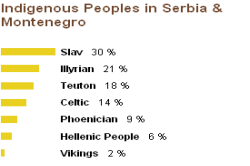 iGENEA has specialized in the genetic origins of Europeans and can now genetically define numerous historical indigenous peoples. By indigenous peoples, we refer here to people groups from Antiquity who are defined not only by their own language, culture and history but also by their own DNA-profile. What is important is not the common linguistic ancestry or the historical-anthropological categorization, but the individual genetic characteristics of a people.
iGENEA has specialized in the genetic origins of Europeans and can now genetically define numerous historical indigenous peoples. By indigenous peoples, we refer here to people groups from Antiquity who are defined not only by their own language, culture and history but also by their own DNA-profile. What is important is not the common linguistic ancestry or the historical-anthropological categorization, but the individual genetic characteristics of a people.
The following results for the indigenous people have been gathered for the west Balkan states: Bosnia and Herzegovina, Albania, Macedonia, Slovenia, Croatia, Serbia and Montenegro.
The results best speak for them selves and they are as follows:






Once we combine the results with the geographical map we get the following:
Map showing indigenous peoples of the West Balkan states (2009)
Also we have Y-haplogroups results for the same contries (Bosnia and Herzegovina, Albania, Macedonia, Slovenia, Croatia, Serbia and Montenegro), and those results are as follows:






Again ones we combine the results with the geographical map we get the following:
Map showing Y-haplogroups of the West Balkan states (2009)
Haplogroup I2a* appears to have originated in the Balkans, perhaps from a glacial refugium there; I2a is very common in Croatia and Bosnia today and decreases in frequency across Eastern Europe. A rare offshoot branch of I2a is also found further West, including in the British Isles. Another subgroup of I2a is by far the most common lineage in Sardinia, but it is also found at low frequencies in France and Spain.
Haplogroup R1a is found today across a large swathe of Asia and Europe and may have originated in South or Central Asia. R1a is most common among Pakistanis, Northern Indians, Russians, Ukrainians and the Kyrgyz and Altai peoples of Central Asia. In Europe R1a is the most common group in Slavic peoples and is also very common in Scandinavia. The presence of R1a in the British Isles is in the main due to Norse Viking ancestry, although Anglo-Saxons and Danes will have carried a smaller proportion there and there is a rare English-specific subgroup. It has been hypothesised that haplogroup R1a was carried to Europe by the Kurgan culture, who domesticated the horse.
Haplogroup E1b1b(*) - defined by the marker M35 - appears to have originated in East Africa, but has been carried from there to the Near East and then on to North Africa and Europe (especially the Mediterranean and the Balkans). Today it is most common in the horn of Africa, North Africa, the Near East and around the Mediterranean. One subgroup decreases in frequency from SE to NW Europe consistent with a dispersal mediated by the arrival of farmers in the Neolithic period, beginning 10,000 years ago.
*Haplogroup E1b1b was formally known as E3b
Haplogroup I2b(*) appears to have originated near modern day Germany, where it reaches it peak frequency. I2b is found spread across a broad area of NW Europe including the British Isles, where it has been brought by numerous historical migrations.
*I2b was formally known as I1b2
The J2 lineage originated in the northern portion of the Fertile Crescent where it later spread throughout central Asia, the Mediterranean, and south into India. As with other populations with Mediterranean ancestry this lineage is found within Jewish populations.
Research note: Many people new to Genetic Genealogy think the J2 haplogroup is synonymous with having male Jewish ancestry. One should note that having a J2 haplogroup assignment does not necessarily indicate Jewish ancestry. The J2 haplogroup is far more ancient than the Jewish religion and is found in many lines with Mediterranean region ancient ancestry. Another relatively more recent mode for J2's entry into some parts of Europe from the Mediterranean areas could have been the Roman Legions and Roman settlements.
References:
http://www.igenea.com/index.php?content=49a&id=38 (24. March 2009)
http://www.igenea.com/index.php?content=49a&id=46 (24. March 2009)
http://www.igenea.com/index.php?content=49a&id=40 (24. March 2009)
http://www.igenea.com/index.php?content=49a&id=42 (24. March 2009)
http://www.igenea.com/index.php?content=49a&id=41 (24. March 2009)
http://www.igenea.com/index.php?content=49a&id=5 (24. March 2009)
http://www.igenea.com/index.php?content=49&id=38 (05. December 2009)
http://www.igenea.com/index.php?content=49&id=46 (05. December 2009)
http://www.igenea.com/index.php?content=49&id=40 (05. December 2009)
http://www.igenea.com/index.php?content=49&id=42 (05. December 2009)
http://www.igenea.com/index.php?content=49&id=41 (05. December 2009)
http://www.igenea.com/index.php?content=49&id=5 (05. December 2009)




